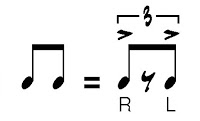We’re laying it on pretty thick with the Reed interpretations right now, but I just went over this with a student, so I need to put up one more. It’s a swing interpretation with partially filled-in triplets, using the 8th note rest and syncopation sections of Reed (pp. 29-44 in the old edition). Alan Dawson called this the “Ruff Bossa” interpretation for reasons I can’t fathom— there are no ruffs involved, and I can’t discern the Bossa Nova connection.
So here’s how to interpret each written beat of the exercises, based on how the notes sound; after p. 32 you’ll be dealing with rhythms that are equivalent to the ones below, but are written differently.
Play written 8th notes as alternating swing 8ths:
Play written quarter notes (or the equivalent) as an 8th note triplet with a RLL sticking, accenting the right hand:
Play notes sounding on an & only as a triplet with a RRL sticking, accenting left:
On beats where there’s no note sounding— like if there’s a rest, or the end of a tied/dotted note, or some combination thereof— use whichever triplet sticking you like, but don’t accent.
Examples after the break:
So line one of Exercise 1, p. 37 in Syncopation would be played as follows, swinging the 8th notes as above:
And line one of Exercise 2:
I should also note that you should not play the accents too mechanically; they need to have a dynamic contour of their own. In general you should accent written tied notes, “hanging” &s with nothing sounding in the next beat, and occasional notes on or off the beat during a longer run of 8th notes. The triplet filler notes should be played very quietly.





Leave a Reply
You must be logged in to post a comment.